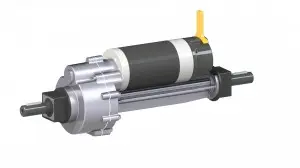How Electric Transaxles Work in Hybrid Vehicles
Introduction
In the rapidly evolving world of automotive technology, hybrid vehicles have emerged as a crucial bridge between traditional internal combustion engine (ICE) vehicles and fully electric vehicles (BEVs). At the heart of this transition is the electric transaxle, a highly integrated system that combines the functionalities of an electric motor, transmission, and differential into a single unit。This blog post will delve into the intricacies of how electric transaxles work in hybrid vehicles, exploring their components, working mechanisms, benefits, and applications.
Understanding Electric Transaxles
Definition and Components
An electric transaxle, also known as an e-transaxle or e-axle, is a compact and highly integrated drivetrain system designed for hybrid and electric vehicles。It typically includes the following key components:
Electric Motor: The electric motor is the heart of the electric transaxle. It converts electrical energy from the vehicle’s battery into mechanical energy to drive the wheels。
Transmission: Unlike traditional ICE vehicles that require complex transmissions, electric transaxles often use simpler transmissions. Some designs incorporate multi-speed gearboxes to optimize performance across a range of speeds。
Differential: The differential allows the wheels to rotate at different speeds, which is essential for turning. In an electric transaxle, the differential is integrated with the motor and transmission to create a compact and efficient drivetrain。
Control Systems: Advanced control systems manage the power delivery and torque distribution, ensuring optimal performance and efficiency. These systems can include electronic control units (ECUs) that monitor and adjust various parameters in real-time。
Working Mechanism
The electric transaxle operates by integrating the electric motor directly with the transmission and differential. When power is supplied to the motor, it generates torque, which is then transferred through the transmission to the differential. The differential distributes the torque to the wheels, allowing the vehicle to move。One of the key advantages of this design is its ability to provide immediate torque, a characteristic of electric motors, resulting in rapid acceleration and smooth driving dynamics。
Applications of Electric Transaxles in Hybrid Vehicles
Hybrid Electric Vehicles (HEVs)
HEVs feature a combination of an ICE and an electric motor. The electric transaxle in an HEV works in conjunction with the ICE and electric motor to efficiently distribute power to the wheels. It helps manage the complex power flows between the different components, ensuring that the vehicle operates smoothly and optimally in both electric and hybrid modes。
Powertrain Configuration: The electric transaxle assists the ICE during acceleration and can take over entirely during low-speed driving or stop-and-go traffic. It also recovers energy through regenerative braking, which is then stored in the battery。
Common Models: The Toyota Prius (non-plug-in version) and the Honda Accord Hybrid are classic examples of HEVs that mandate electric transaxles. These vehicles have demonstrated the effectiveness of electric transaxles in enhancing fuel economy and reducing emissions while maintaining a high level of performance and drivability。
Plug-in Hybrid Electric Vehicles (PHEVs)
PHEVs combine an ICE with an electric propulsion system and can operate in all-electric mode for a certain range before the ICE takes over or works in tandem with the electric motor。
Operational Mode: During electric-only operation, the electric transaxle is responsible for transferring power from the electric motor to the wheels. When the ICE is engaged, the electric transaxle may continue to assist in power delivery or switch to a different mode based on the vehicle’s power management system。
Examples: The Toyota Prius Prime and the BMW 530e are well-known PHEV models that incorporate electric transaxles. These vehicles utilize the electric transaxle to maximize fuel efficiency and reduce emissions by allowing for extended electric-only driving ranges。
Fuel Cell Electric Vehicles (FCEVs)
FCEVs generate electricity through a chemical reaction between hydrogen and oxygen in a fuel cell stack. This electricity powers an electric motor, which drives the wheels。
Fuel Cell Technology: Similar to BEVs, FCEVs require an electric transaxle to transmit the power from the electric motor to the wheels efficiently. The electric transaxle in an FCEV is designed to handle the unique power characteristics of fuel cell systems, ensuring reliable and powerful performance。
Applications: While FCEVs are not as widespread as BEVs and PHEVs, they represent a promising clean energy alternative for the future. Examples of FCEVs include the Hyundai Nexo and the Toyota Mirai。
Benefits of Electric Transaxles in Hybrid Vehicles
Efficiency in Power Distribution
One of the key advantages of electric transaxles is their efficiency in power distribution. By combining multiple components into a single unit, electric transaxles reduce energy losses that occur when power is transferred between separate components。
Contribution to Fuel Efficiency
In hybrid vehicles, the electric transaxle contributes significantly to fuel efficiency. It allows for smooth switching between electric and gasoline power, optimizing the vehicle’s energy use。
Enhancing Vehicle Performance
Electric transaxles contribute to improved vehicle performance by providing quick and efficient torque delivery. This allows for better acceleration and overall performance, especially in hybrid vehicles where the electric motor’s instant torque can be fully utilized。
Future Trends and Developments
As the automotive industry continues to evolve, electric transaxles are expected to become even more efficient and compact. Advances in materials science, manufacturing techniques, and control systems will further enhance their performance and reliability。Additionally, the increasing adoption of hybrid and electric vehicles worldwide will drive demand for electric transaxles, making them a crucial component in the future of sustainable transportation。
Conclusion
Electric transaxles play a vital role in the operation of hybrid vehicles, providing a seamless integration of electric and traditional propulsion systems. Their ability to enhance fuel efficiency, improve performance, and reduce emissions makes them an essential technology in the transition to a more sustainable automotive future。As manufacturers continue to innovate and refine this technology, electric transaxles will undoubtedly remain at the forefront of automotive advancements.
Post time: Aug-06-2025


